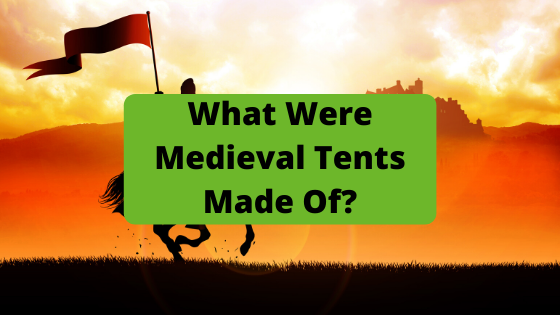Are you a tent enthusiast but now you’re wondering what the tents were made of in ye old days?
Do you want to learn more about the history of tents?
While camping may not seem connected to the Medieval days, there’s still some things to be learned from how tents have been made over the centuries. For this reason, you may be asking yourself:
What were medieval tents made of?
Medieval tents usually came from blanket-like materials available at the time such as wool or some type of linen. Modern imitation tents use linen and cotton canvas to simulate the older style, though the material is better treated to resist water and mildew. Medieval tents were commonly held up by ropes and wooden poles to create a cone-like shape throughout.
Read ahead for more details and examples.
Table of Contents
What Were Medieval Tents Used For?
Medieval tents were used largely as temporary housing or rooms when groups were traveling. Most commonly were the use by military groups or higher-tier citizens and their entourage.
The common soldier used a drop sheet made of linen or wool and poles to assemble simple covering as tents and shelter when travelling.
Those with more money such as nobility or merchants would have more elaborate tents often referred to as pavilions.
These pavilions had a lot of space in them. They were usually cone-shaped with sides that could be dropped or lifted depending on the weather and use of the space.
Some of these tents were used for the following reasons:
- Storage
- Sleeping for nobility or those with more money
- Eating spaces
- Selling products
- And more!
The tents had a large range of sizes from the single occupancy just for sleeping to housing whole groups of people.

What Were Medieval Tents Made Of?
Medieval tents were made of the same materials people used to make sheets and coverings in other places back then.
It’s a common misconception that cotton was in prevalent use back then. This isn’t the case at all.
Canvas materials were in use, but cotton wasn’t common.
The two biggest materials used were linen and wool canvas.
Linen was useful though more expensive. It was lighter and easier to manage.
Wool was a common material found during these days and made up most of the tent materials.
Wool was great in cold weather and handled wind well due to its higher weight.
This was good and bad, though. When wet, wool was almost unbearably hard to transport and really hot.
The lighter tent materials and smaller soldier throw tents were carried by the soldier as they traveled. The heavier and larger medieval tents would be carried in wagons or by pack animals, and then they’d be thrown up when the group reached its destination or settled down for the night.
Today’s medieval-style tents are mostly made of cotton canvas. Some are made from a heavier synthetic polycotton (as opposed to the standard polyester for common camping tents).
Very rarely is actual wool used in today’s medieval-style tents. You’ll mostly find these styles of tents used at Renaissance Fairs around the world.
The materials in today’s tents modeled on this historical style are treated with modern water and sun proofing treatments to increase its resistance to water and UV damage.
The modern materials are also more breathable and therefore more tolerable in hot weather.
They’re also more resistant to mold which was a huge and common problem with medieval tents.
Learn more about what materials tents are made of.
Where Can I Buy A Medieval Tent?
If you’re interested in medieval tents, there are several places you may want to look. It takes a little work, but they’re out there.
Or, just go with the suggestions in this section.
Medieval Market
Visit the site – https://medieval-market.com/medieval_tents.php
This website is a cool place for all sorts of medieval-themed items. For tents, they sell a variety of them in different sizes and styles.
For extra price, they even color and style them to your specifications.
Medieval Market treats these materials with high quality processes leading to a durable and long-lasting product.
They look great and are sure to impress anyone even a little interested in getting a medieval tent
Online Retailers
It takes some work, but there are options out there for medieval-like tents on shopping platforms such as Amazon.
Whether you go for a modern bell-style such as this Danchel Bell Tent (click to check price on Amazon) or a cone-shaped Tipi tent such as this one by Wenzel, there are things out there for you.
The bell tent is the modern-day equivalent of the medieval cone tent.
Panther Primitives
Click to check website – http://www.pantherprimitives.com/medieval.html
Panther Primitives makes specialty tents including medieval tents.
This company is trusted for its quality, though it’s not as dedicated to the historical style of tents.
Tent Smiths
Click to check website – https://www.tentsmiths.com/
Tent Smiths are the place to go for any historical period tent including medieval tents.
They specialize in creating tents and pavilions to match the period as closely as possible using modern manufacturing processes and treatments.
The biggest downside: a higher price. This perfection is the result of experts and hard work, but you won’t be disappointed with the quality of the tent you receive.
Renaissance Fairs
It’s often possible to buy a medieval tent from a Renaissance fair. These will be packaged up and easily available.
Usually, they look and work just fine.
You won’t get a lot of control in how they look, but they are sometimes a little cheaper than other specialty tents.
Final Thoughts
We hope you enjoyed learning a little about what medieval tents were made of. Wool and linen were the most common materials for these cone-shaped shelters.
Feel free to visit the links above the check out the possibility of getting your own and being the talk of your campsite.
Here are some related readings you may also enjoy:

